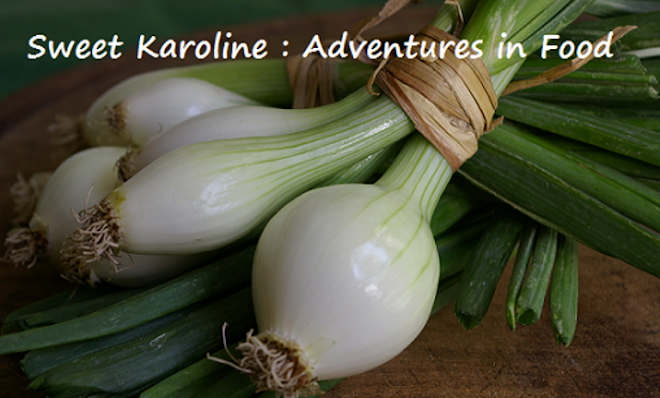
As posted by Carlie on Girls Guide to the Galaxy -- she is much too kind!
http://girlsguidetothegalaxy.com/2009/12/08/christmas-cookie-classics/
The holidays are a great excuse to stuff ourselves silly and not feel guilty about it because as the oft-used justification goes, “It’s a special occasion.” It is the time of year when people young and old take to their kitchens to produce baked goods with wild abandon. Probably the most beloved of all holiday treats is the one and only thing Santa himself demands in exchange for his lavish and physically demanding gift-giving efforts: the Christmas cookie.
Since I’ve proven myself to be pretty useless in the kitchen on most accounts, I decided to ask Karoline Boehm-Goodnick, a San Francisco pastry chef (and in the interest of full disclosure, my husband’s cousin’s wife), for some of her favorite Christmas cookie recipes. Below is what she sent, and in my personal opinion, they all sound delicious! For more of her recipes and chronicles of her attempt to eat only unprocessed food in the year 2010 (ambitious!), check out her excellent blog, Sweet Karoline: Adventures in Food and resist the urge to lick your computer screen – she’s also a food stylist, and the photos are amazing!
Grandma Esther’s Spritz Cookies No Christmas table is complete without these miniature trees, candy canes, and rosettes. A classic recipe, my favorite are the Christmas trees, tinted green and covered with shimmering red and green sprinkles. If you want to tint the dough, it is easiest to add the food coloring with the butter. Use more drops than you think necessary; there is a lot of flour to be added later. Use ungreased baking sheets so that the cookie sticks to the pan as you are piping them—don’t worry, they won’t stick during baking. If you don’t have a cookie press, you can use a piping bag fitted with a star tip – it is a little more difficult, and the cookies won’t be so uniform, but the results will be just as delicious.
Makes 3 to 4 dozen cookies
Ingredients
1 pound (4 sticks) butter, at room temperature
1 cup sugar
2 egg yolks
1 teaspoon vanilla
1 teaspoon baking powder
5 cups flour
Pinch of salt
Sprinkles for decorating
Directions
1. Set the oven at 350 degrees. Have on hand a cookie press and several baking sheets.
2. In the bowl of an electric mixer fitted with the paddle, cream the butter and sugar until light and fluffy, approximately 3 minutes on medium high.
3. Scrape down the sides of the bowl, and mix in egg yolks and vanilla.
4. Sift baking powder, flour, and salt. Mix in dry ingredients, on low speed, until flour is incorporated.
5. Using a cookie press, press onto an ungreased cookie sheet approximately one inch apart. If you would like to decorate the cookies with sprinkles, do so at this time.
6. Bake for 12 minutes, or until the edges of the cookies begin to brown very slightly.
7. Using a spatula, carefully remove cookies from the pan to cool on a rack.
8. Store in an air-tight container for up to 1 week.
Christmas Crescents In my family, these treats always came in the shape of a crescent moon, but many friends have told me that their families make the same recipes in ball shape. Feel free to try either one.
Makes approximately 2 dozen cookies
Ingredients
½ pound (2 sticks) butter, at room temperature
5 tablespoons sugar
1 tablespoon water
2 teaspoons vanilla
2 cups flour
¼ teaspoon salt
2 cups chopped pecans
Butter for greasing the pan
Powdered sugar for rolling
Directions
1. Set the oven at 325 degrees. Have on hand several baking sheets.
2. In the bowl of an electric mixer fitted with a paddle, cream butter and sugar until light and fluffy, approximately 3 minutes on medium high.
3. Scrape down the sides of the bowl, and mix in water and vanilla.
4. Sift flour and salt. Add flour, salt, and pecans to bowl. Mix until just combined.
5. Take 1 teaspoon of dough into your hand, and shape it into a crescent. Place onto a greased cookie sheet. Repeat with the remaining dough.
6. Bake for approximately 20 minutes, or until the bottoms begin to brown.
7. Cool on a wire rack for at least 10 minutes.
8. Roll the cookies in powdered sugar to coat the outsides. Be careful, as the cookies are extremely delicate. Cool completely on a rack.
9. Store in an air-tight container for up to 1 week.
Mom’s Gingerbread Cookies This recipe for gingerbread cookies is the same one that my mom used every year when I was a kid. We had 6-inch cutters to make giant gingerbread men and women, but you can use any size. The dough rolls out far easier than any I have ever worked with – no need to chill it or wait for it to relax. Decorate as you like. A piping bag, a spatula, and several colors of icing will keep the kids occupied for hours.
Makes approximately 3 dozen cookies
Ingredients
COOKIES
½ cup sugar
½ cup molasses
1 ½ teaspoons ground ginger
1 teaspoon ground allspice
1 teaspoon ground cinnamon
1 teaspoon ground cloves
2 teaspoons baking soda
½ cup (1 stick) butter, cut into pieces
1 egg, beaten
3 ½ cups flour
Flour for the board and cutters
Directions
1. Set the oven at 325 degrees. Have on hand several baking sheets and cookie cutters.
2. In a 3-quart saucepan, bring sugar, molasses, ginger, allspice, cinnamon, and cloves to a boil, stirring occasionally.
3. Remove saucepan from heat, and stir in baking soda. Mixture will foam up and become frothy.
4. Stir in butter until fully melted. Stir in egg.
5. With a rubber spatula, stir in flour. When the dough has mostly come together, turn it out onto a lightly floured surface. Knead until all is incorporated.
6. Divide dough in half. Wrap half in plastic, and set aside.
7. Using a rolling pin, roll out unwrapped dough to ¼ inch thick.
8. Using a floured cookie cutter, cut out each cookie, placing them on a greased baking sheet, approximately 1 inch apart.
9. Bake cookies for 12 minutes, or until the edges begin to brown. Remove cookies from pan, and cool on a wire rack.
ICING
Ingredients
2 egg whites
2 teaspoons lemon juice
3 cups powdered sugar, sifted
Food coloring (optional)
Directions
1. In the bowl of an electric mixer, fitted with a whisk, beat egg whites, lemon juice, and powdered sugar until stiff, about 5 minutes on high speed.
2. Tint icing with a few drops of food coloring, if you like. Immediately transfer to an air-tight container or a piping bag, as icing will harden very quickly.
3. Cover the unused icing with plastic wrap, pressing it to the surface to keep the icing from forming a skin.
4. Decorate cookies. Allow them to dry for several hours before stacking or placing in a container.
5. Store in an air-tight container for up to 1 week.
Carlie is the Food and Drink Editor for Girls Guide. By day she is an educational textbook editor, and she moonlights as a foodie and barfly. You can email her at carlie [at] girlsguidetothegalaxy [dot] com, and you can follow her on Twitter – @carbirwin.













 In today's Boston Globe is a cherished recipe that I learned from my mom. I can sense your skepticism, but trust me, it's amazing and totally worth the effort.
In today's Boston Globe is a cherished recipe that I learned from my mom. I can sense your skepticism, but trust me, it's amazing and totally worth the effort.














